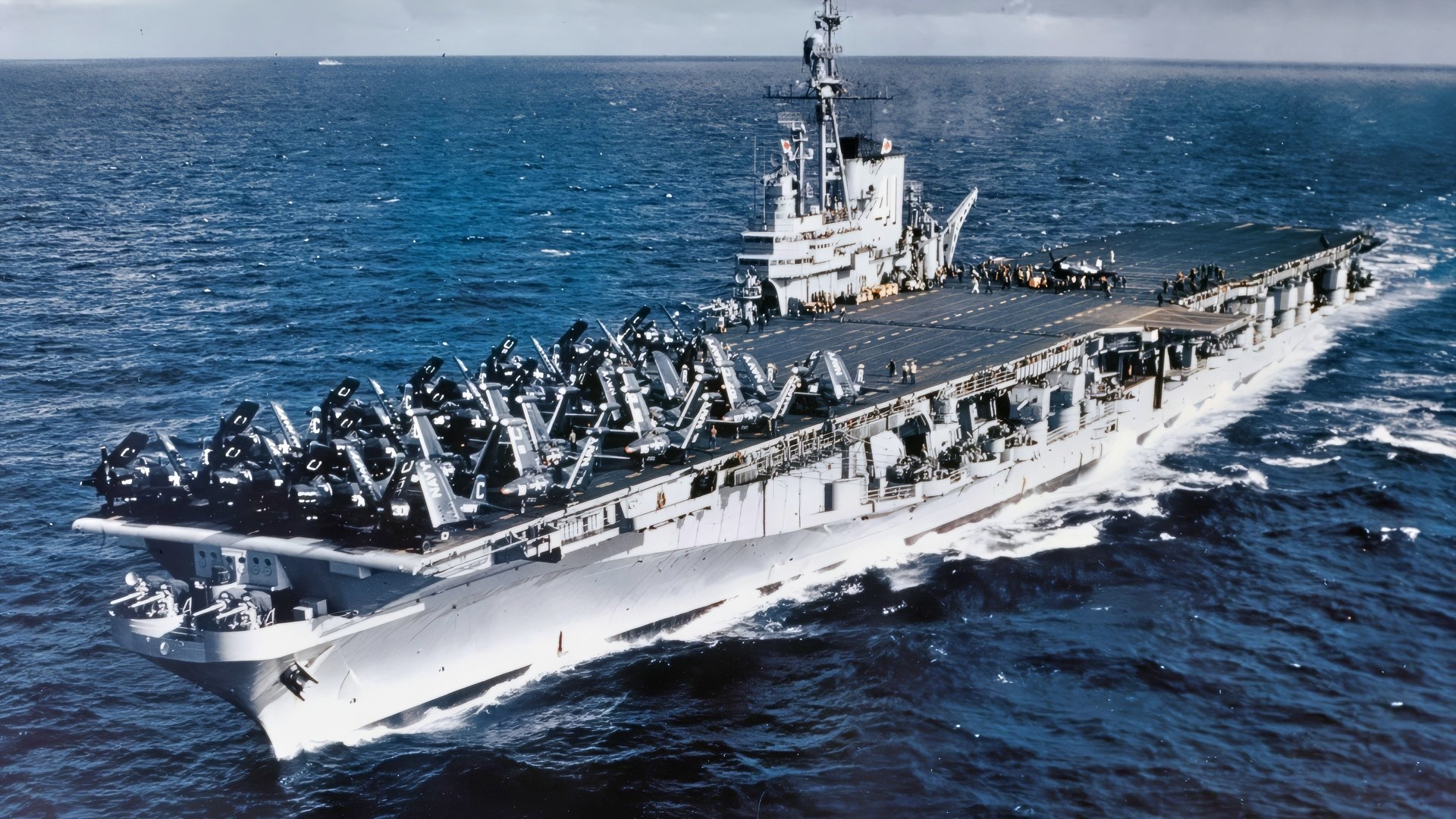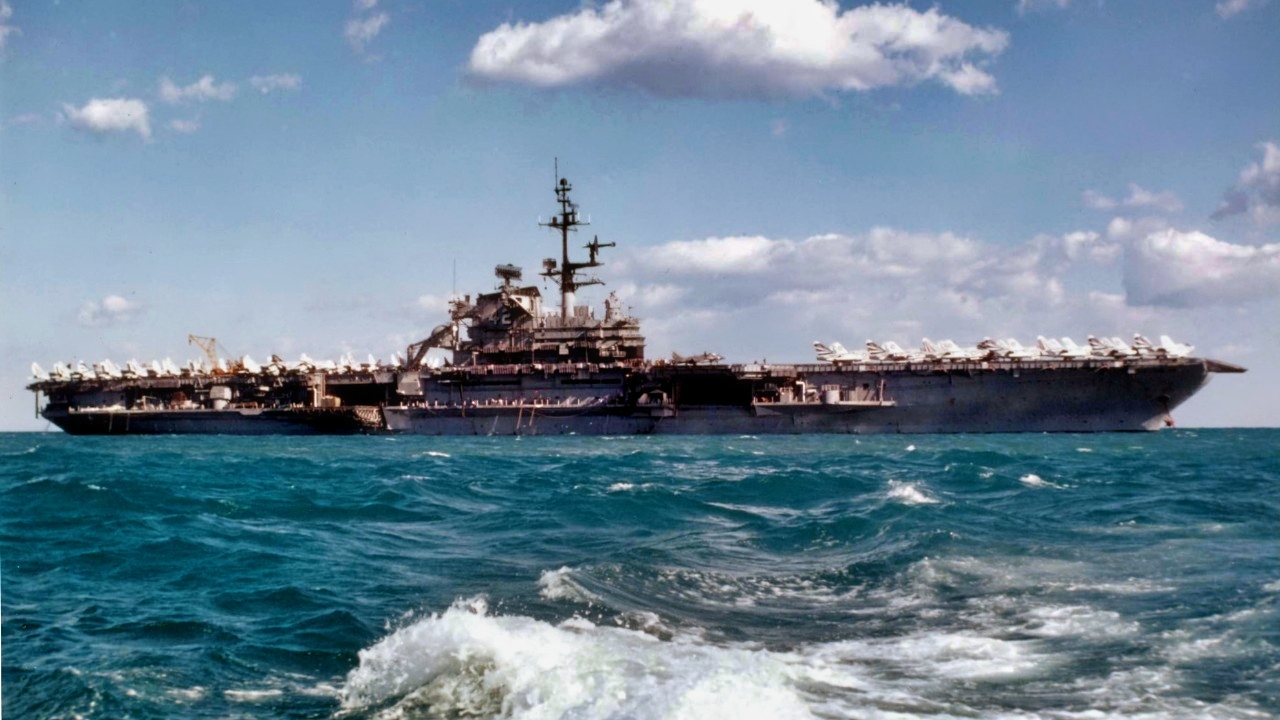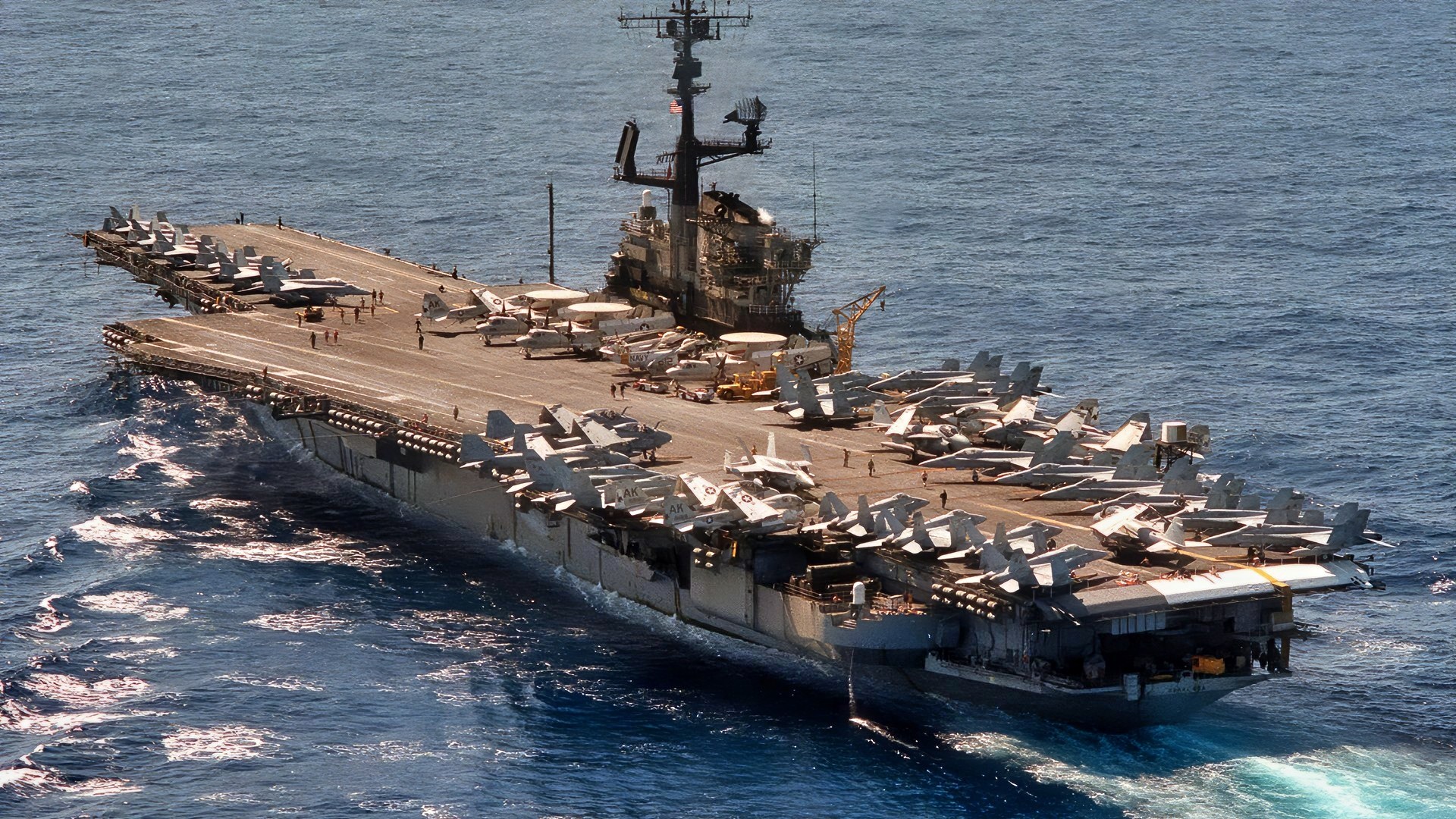Key Points and Summary – Nicknamed the “Ageless Warrior,” the aircraft carrier USS Coral Sea (CV-43) had an exceptionally long career, serving from the 1940s to 1990 under ten U.S. presidents.
-Built with an armored flight deck, the Midway-class carrier was a constant presence in global crises.

USS Midway Aircraft Carrier of Midway-Class. Image Credit: Creative Commons.
-She evacuated U.S. citizens during the Suez Crisis, set records for combat sorties during the Vietnam War, stood ready during the Iran Hostage Crisis, and launched strikes against Libya in 1986.
-After a massive mid-life modernization, the decorated warship was finally decommissioned just before the Gulf War.
Meet USS Coral Sea (CV-43)
The USS Coral Sea (CV-43) was known as the “Ageless Warrior,” because it enjoyed an uncommonly long life. CV-43 remained at sea from the 1940s until 1990, meaning it lasted across six decades and served under 10 different U.S. presidents.
“Capitalizing on wartime experience, Coral Sea and her sisters, Midway (CV-41) and Franklin D. Roosevelt (CV-42), were constructed with the most advanced damage control innovations possible, including an armored flight deck and intensive internal subdivision not found on any carrier or other combatant before or since,” the USS Coral Sea tribute website said.
According to an article on the website of the Nemeroff Law Firm about the history of the Coral Sea, the ship was ordered by the Navy in June 1943, and it was laid down at Newport News Shipbuilding and Dry Dock Company on July 10, 1944.

Midway-Class Aircraft Carrier. Image Credit: Creative Commons.
It wasn’t until after the end of World War II, on April 2, 1946, that the ship was launched, and it was commissioned the following year. Captain A.P. Storrs II was the ship’s first commander.
“USS Coral Sea took part in training exercises and overhaul until May 1949, when she spent her first deployment with the Sixth Fleet in the Mediterranean Sea. Her second deployment was also with the Sixth Fleet in the same location from September 9, 1950, to February 1, 1951,” the Nemeroff Firm story said.
Life as a Flagship
In 1951, the USS Coral Sea became the flagship for the Commander of Carrier Division 6, taking part in NATO Exercise Beehive I, during which it joined British, French, and Italian ships.
The ship spent much of the 1950s participating in training exercises and sometimes greeting visiting foreign dignitaries.
When the Suez Crisis hit in 1956, the USS Coral Sea was deployed to evacuate American citizens from Egypt.
“Coral Sea had departed Istanbul 27 October, and two days later was still en route to Cannes, when the Suez Crisis erupted,” the tribute website said. “The carrier was sent to assist other ships of the 6/h Fleet in evacuating and protecting Americans in the area. She operated off the coast of Egypt into late November, then resumed more routine operations in the Western Mediterranean.”
A Major Remodeling
The following year, in 1957, the ship was decommissioned, and it began a massive modernization.
That remodeling, at Puget Sound Naval Shipyard, involved what the tribute website called “a virtual reconstruction,” over 33 months. Changes included the “installation of three C-11-1 steam catapults, angled deck, enclosed hurricane bow, Mk-7-Mod 2 arresting gear identical to that installed in the Forrestal-class carriers, three new deck-edge elevators and new weapons elevators. In addition, hull blisters widened her beam to a matronly 120 ft. to accommodate the increase in her displacement.”
The Coral Sea was recommissioned, with its new look, in January 1960, with Capt. James S. Gray Jr., named the new commander. It became, per the history website, “the first carrier to deploy as the result of President Dwight D. Eisenhower’s decision to keep three attack carriers on the line with 7th Fleet at all times.” During this period, the Coral Sea helped to test out the Pilot Landing Aid Television (PLAT) system.
To Vietnam
After the Gulf of Tonkin incident in 1964 and the escalation of U.S. involvement in the Vietnam War, the USS Coral Sea headed back to the Pacific.
“Her aircraft launched strikes against Dong Hoi on February 7, 1965.”
As the USS Coral Sea history website described it, “20 aircraft launched from Coral Sea’s flight deck, to join those from Ranger and Han-cock (CVA-19). Coral Sea’s CVG-15 led the retaliatory strike on the Dong Hoi military barracks, reputedly one of the staging areas for Viet Cong infiltrators into South Vietnam, in the largest single such effort since the Korean War.”
“On March 26, she joined in Operation Rolling Thunder, bombing military targets throughout Northern Vietnam. She sailed home on November 1, 1965,” the Nemeroff Law website said.
The ship continued to participate in the Vietnam War until the end of U.S. involvement, playing a part in Operation Freedom Porch, Operation Pocket Money, and Operation Frequent Wind — the evacuation of the last U.S. forces from Saigon as the city fell in 1975.
Even after that, the Coral Sea was part of the operation to recover the merchant ship SS Mayaguez after Cambodia’s Khmer Rouge seized it. The ship “flew protective air strikes to cover the landing teams that rescued the crew and secured the merchant ship.”
The USS Coral Sea logged 10,000 combat sorties in Southeast Asia, which it called “a record for carriers with one air wing during a single combat cruise.”
Another Overhaul
After the Vietnam War was over, the USS Coral Sea headed back to California for an $80 million overhaul, “during which the last of her 5-inch battery and all gun directors were removed,” the history website said.
Before the end of the decade, the ship took part in attempts to resolve the Iranian hostage crisis. The taking of American hostages in Tehran, the history website said, “sent CV-43 into the Indian Ocean as Midway’s relief.”
The failed attempt to rescue the hostages was launched from the Nimitz (CVN-68), while “Coral Sea’s planes were armed and stood ready to execute several contingency cover and strike operations in support of aircraft on the ground and in their exit from Iranian airspace.”
The ship saw combat once again in the 1980s, when Libyan forces fired on Americans in March 1986, and aircraft took off from the Coral Sea. They repeated the feat the next month, as part of Operation El Dorado Canyon.
The ship, first developed during World War II, finally ended service on the eve of the Gulf War. The USS Coral Sea was decommissioned on April 26, 1990, struck from the register two days later, and sold for scrap in May 1993.
About the Author: Stephen Silver
Stephen Silver is an award-winning journalist, essayist, and film critic, and contributor to the Philadelphia Inquirer, the Jewish Telegraphic Agency, Broad Street Review, and Splice Today. The co-founder of the Philadelphia Film Critics Circle, Stephen lives in suburban Philadelphia with his wife and two sons. For over a decade, Stephen has authored thousands of articles that focus on politics, national security, technology, and the economy. Follow him on X (formerly Twitter) at @StephenSilver, and subscribe to his Substack newsletter.
More Military
Canada’s F-35 Fighter Program Has Passed the Point of No Return
USS Oriskany: The Navy Essex-Class Aircraft Carrier That Was Sunk On Purpose
Nimitz-Class Nuclear Aircraft Carrier USS John C. Stennis ‘Out Action’ for 5 Years
Australia’s Mogami-Class Frigate Buy from Japan Is a Big Deal
The F-14 Tomcat Fighter Could Stop Enemy Tanks In Their Tracks










